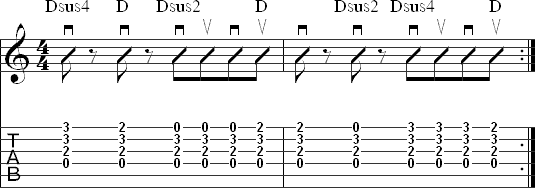What You Should Know
What You Will Learn
- Strumming patterns with quarter and eighth notes
- Strumming with chord changes
How to Strum Eighth Notes
How to Strum Eighth Notes
Strumming eighth notes requires a steady up and down motion of the strumming hand. The downstroke should occur on the beat and the upstroke should occur on the 'and'. This is shown below:

Strumming Patterns
Practice each of the patterns below with a single chord. You can use any chord for practicing. Once you are comfortable with the patterns on a single chord, start working on the exercises at the end of the lesson.
The patterns below include a combination of quarter and eighth notes. It will be easier to keep time and maintain the strumming pattern if you use a continuous up and down motion of your arm. When you have a quarter note, you should strum down on the downbeat and make an upward motion with the hand on the 'and' of the beat while missing the strings. This gets your arm in position for the next downstroke.
Strum Pattern 1 - Straight Eighths
Pattern

Strum Pattern 2 - Quarter and Two Eighths
Pattern

Comments
This pattern alternates between quarter and eighth notes every beat. Make sure you return to a position above the strings after playing each quarter note to prepare for the next downstroke. This can be done by making a continuous strumming motion and "missing" the strings when making an upstroke on the beats where a quarter note occurs.
Strum Pattern 3 - Two Eighths and a Quarter
Pattern

Comments
This pattern reverses the rhythm in pattern 2.The rest of the strum patterns have rhythms similar to the previous patterns (i.e., only quarter and eighth notes), so keep in mind the practice tips given above. You should always keep a constant strumming motion in each of these patterns. If there is any jerkiness in your strumming, your rhythm is probably incorrect. Make sure you count all eighth notes (including beats where there are only quarter notes), at least in the beginning, to ensure that you are playing the rhythms correctly. Proper rhythm is one of the most essential parts of developing strumming technique.
Strum Pattern 4 - Two Quarters and Fourth Eighths
Pattern

Strum Pattern 5 - Four Eighths and Two Quarters
Pattern

Strum Pattern 6 - Quarter and Six Eighth Notes
Pattern

Strum Pattern 7 - Six Eighth Notes and a Quarter
Pattern

Exercises
Exercise 1
Exercise 1 is a I IV V chord progression in C major. Use the chord progression reference to move this exercise to other keys.

Exercise 2
Exercise 2 features a I vi IV V progression in G major with quarter note rests in the first measure and straight eighth notes in the second measure. Make sure that you are immediately switching to the next chord during the rests. There is no need to keep holding a chord once you have muted it, so use this time to get from the G to Em chord and from Em to C.

Practice this in other keys using the I vi IV V reference to transpose the progression to other keys.
Exercise 3
Exercise 3 is a rock-style strumming riff in D major. The progression uses only three chords: D, Dsus2, and Dsus4. The chord changes should be relatively easy, because you only need to change one finger to move to the next chord. The challenge will be in muting for the eighth note rests. These go by faster than the quarter note muting patterns you have practiced previously, but the concept is the same. Start very slowly and make sure you count.
The exercise is also shown in tablature to make the chord changes clearer.

Further Practice
Come up with your own chord progressions using the various eighth note strumming patterns given in this lesson.

Comments
Keep your arm moving up and down continuously and smoothly while practicing this pattern.